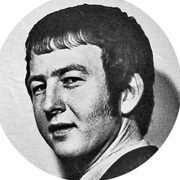
Roy Good
Roy Good's creative career began early: at age 12, his cartoons were published in Christchurch newspaper The Press. Every Saturday morning one could find the tween in art classes at Canterbury College School of Arts. Following a gap year after he left high school, Good headed back to the college to start an arts degree, majoring in painting.
Good moved to Auckland in 1966 to study at teacher's college, but dropped out before the year-long course was up (a high school placement made him realise teaching young students wasn't for him). After working as a labourer for the railways, he was happy to return to art when he landed a scenic artist role at the NZ Broadcasting Corporation.
One of the shows Good worked on was C'mon, the appointment viewing pop music show of its time. The programme was a black and white frenzy of pop art sets, go-go girls, choreographed musicians and fast cutting, hosted by Peter Sinclair. Under the leadership of head designer Anthony Stones, Good and fellow artist Alan Pearson painted sets, and designed graphics and artwork for the iconic opening titles.
"We were charged with reflecting the pop culture of the times," recalls Good in book Parallel Universe: The Art and Design of Roy Good. "The opening titles of the show consisted of a replica of [English artist] Bridget Riley's Blaze that I copied onto a board and mounted on a wheel that was rotated in front of a studio camera. It was then multi-screened and formed the background of the show's opening titles."
Television had been on air in Aotearoa for just seven years, and there was little professional experience in the industry. "We sort of made it up as we went along as it was all so new." In 1968, Good and Pearson took over design on C'Mon.
In the 1970s and 80s Good went on to design studio sets for many other programmes including Hudson & Halls, Happen Inn, arts series Kaleidoscope, variety show The Late Show and Blind Date. He also designed graphics for several news and current affairs programmes such as Top Half, Eyewitness, News at Six and News At 10, and logos for Telethon and drama series Gather Your Dreams. Designing logos became Good's specialty. In 1976 he created this eye-shaped South Pacific Television logo for the new second channel (the koru-based design reflected Good's interest in biculturalism). In 1980 he designed the iconic red, white and blue logo featuring the Southern Cross constellation, for Television New Zealand. Alongside being a respected designer, Good was also an accomplished painter holding solo exhibitions.
In the early 1980s, he was made Head of Design at TVNZ, overseeing 140 staff. "The TVNZ art department of these times, especially in the 70s and 80s, was the largest art department in the country," says Good.
He resigned from TVNZ in 1989, but continued with freelance design and art directing, as well as teaching design at tertiary level. He designed branding for Telethon in 1981 and New Zealand's contributions to Expo 88 and 92. In-between he worked alongside Māori sculptor Fred Graham, to mark the Sesquicentennial 150 year celebrations of the Treaty of Waitangi's signing. The logo features a kōtuku (white heron). Good also submitted a design for Te Papa museum's main branding in 1992, but ultimately Saatchi & Saatchi's thumbprint won out.
Good has been working full time on his own art since 2008.
Profile written by Natasha Harris
Published on 21 February 2019
Sources include
Roy Good
Edward Hanfling, 'Introduction,' in Parallel Universe: The Art and Design of Roy Good. Editor Edward Hanfling (Auckland:Te Uru Waitākere Contemporary Gallery, 2018)
Andrew Paul Wood, 'The Day Job,' in Parallel Universe: The Art and Design of Roy Good. Editor Edward Hanfling (Auckland:Te Uru Waitākere Contemporary Gallery, 2018)